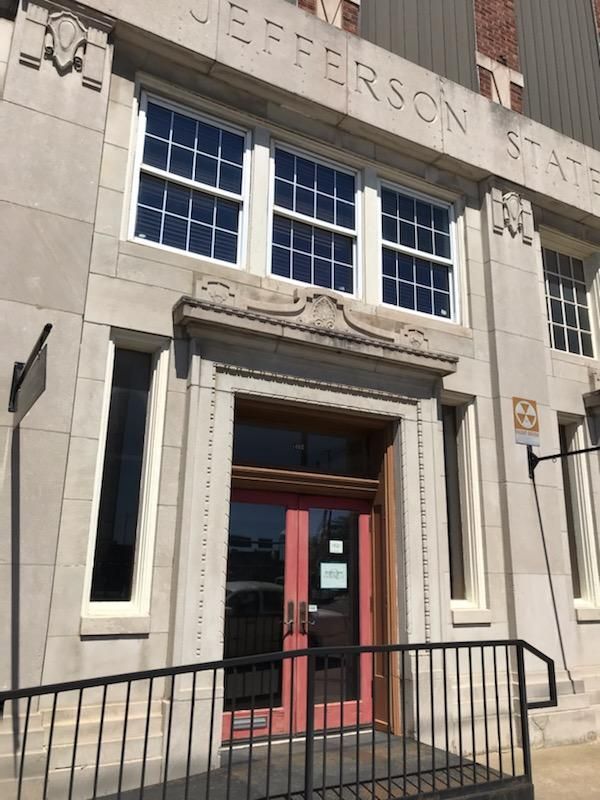What Remains is a House — A History of the Pace Family
By Sean Tolley
Whether recognized consciously or not, the history of a given place never stops informing that same place’s present tense existence.
In other words: You walk into the offices of Quinn Law & Mediation, LLC, and it’s instantly understood that the structure (the house) isn’t just old. It’s quality old – possessed of a sort of sturdiness that humbles the ambitions of the “McMansions” built later. The walls are thick, and though the floors may sometimes creak, they never give; the foundation, a work of bricklaying perfection. This house is 104 years old because it was built to be 104 years old.
Likewise, the woodwork, the fireplaces, the pocket doors – they all speak to the small town wealth, if not the significance of the builder, but do so by way of a simple, timeless elegance designed to still be admired 104 years later.
The original fireplace in the reception area at QLM
To the extent, then, that “timelessness” can be perceived as “perpetual relevance,” the overall affect of such craftsmanship and style is to immediately tease the visitor’s curiosity as to the identity of the builder. A clever, harmless ruse designed to help keep one’s name relevant even long after one’s soul has taken flight….
The Builder
Somewhere in this house, at five minutes past midnight, on the 23 rd of January, 1948, the soul of retired attorney and judge William T. Pace left his 94 year old body and began winging its own way to Eternity.
Thirty-four years earlier, when he and his wife, Emma, moved into their new home at 901 North Street, he was still a practicing lawyer engaged in a thriving career. His individual reputation as a first-rate jurist was set firmly in place by three terms as County Judge. He possessed no apparent plans to retire.
Indeed, in 1932, as he approached his 79 th birthday and his 55 th year at the bar in Jefferson County, he was appointed City Attorney for Mt. Vernon.
Of special significance, however, is the fact that the William T. Pace who built and occupied this house in 1914 was a man who was seven years into his tenure as the latest (and, according to his obituary, the last) “patriarch” of a sprawling family dynasty. This family not only connected the judge’s rapidly modernizing community to its origins as a pioneer village a century earlier, but its lineage also provided direct connection to the Revolution itself.
His Family
Long Story Short: Judge William T. Pace was the only surviving son of James M. Pace. (Judge Pace had a brother, Thomas, who died in infancy.) Judge Pace’s father, James M.Pace, was the oldest son of Harvey T. Pace, who was the oldest son of John M. Pace, who was the oldest son Joel Pace Sr., a Revolutionary War veteran. Joel Sr., the great-great grandfather of Judge Pace, like many Virginians in the years following the War for Independence, migrated west into Kentucky. There land was cheaply available to men like Joel and the three brothers who moved with him.
Men whose inheritance was minimal, if existent at all.
But it wasn’t Joel, Sr., who brought the family to Illinois. Rather, over the twenty years separating Joel’s move and the adulthood of his children, conditions changed in Kentucky. Land speculation and the expansion of the heavily-stratified Southern plantation (slave) economy in Kentucky not only made it difficult for the latest generation to establish themselves “at home,” but made staying difficult to justify at all. This was particularly true when just across the Ohio River in the still sparsely-populated Territory/State of Illinois land was readily available and cheap. Opportunities for farmers, laborers, and businessmen appeared to be endless.

The exterior of our office building, the former home of Judge and Mrs. William T. Pace
The Family Comes to Illinois
Thus, it was Joel’s twin sons, the uncles of Judge Pace, who first tested the waters in Illinois. Joel, Jr. and Joseph were 27 years of age and both veterans of the War of 1812. For Joel, Jr., the road to Mt. Vernon was hardly straight. Hired by a merchant from Vincennes, Indiana, to work as a salesman, he removed from Frankfort, Kentucky, and spent two years there. Unfortunately, his employer “abandoned himself to drink,” and so Joel, Jr., descended the Wabash and Ohio rivers to Shawneetown, Illinois. There he worked for riverside merchants Peoples & Kirkpatrick. It was while working in Shawneetown that Joel, Jr. made down-payment on 480 acres in Pope County on the 23 rd October 1818. Joel, Jr. made this investment in both his name and Joseph’s, though Joseph appears to have remained in Kentucky for the time being. However, they soon wound up defaulting as a result of Joel Jr.’s blossoming friendship with circuit court judge (and former representative in the Territorial Legislature) Thomas C. Browne, who lived in Shawneetown at the time. Thomas C. Browne had just received appointment as one of the first four justices on the Illinois Supreme Court. Browne recommended Joel for the position of county clerk for the newly organized county of Jefferson, which was carved out of Edwards and White counties. By the following spring, Joel Jr. had relocated to Mt. Vernon, which was then only twenty acres big and occupied by a handful of transplanted Southerners. Officials swore Joel Jr. in as county clerk, a position he held until 1837. Joel Jr. purchased acreage north of town at what is now the former site of Good Samaritan Hospital. He entered into mercantile business with Isaac Casey ( Zadok Casey ‘s older brother), and hired his own twin brother to survey roads in the new county.
Over the next several years, most of the rest of the Pace family followed to Illinois. Joel, Sr. and his oldest son, John M., the father of Judge Pace, settled land just west of Casey Fork in Dodds Township. Already in his late fifties when he moved, Joel, Sr. quietly farmed a small parcel until his death on 31st August 1831, aged 69 years. His wife, Mary (who, between 1783 and 1811, gave birth to fifteen children, including two sets of twins), survived Joel by eighteen years. She died at the age of 85 – no small feat in the middle of the nineteenth century, particularly considering she was “crippled in her old age by a fall from a horse.”
Both are buried in Pace Cemetery…
…which brings us back to the judge, William T. Pace.
Specifically, it brings us to his wife, Emma, who died at Jefferson Memorial Hospital on February 22, 1948 – almost exactly one month after her husband’s passing.
Emma Pace and the D.A.R.
On Memorial Day, 1922, members of the local Chapter of the Daughters of the American Revolution (D.A.R.) gathered with friends and family. They met near the rear of Pace Cemetery and held services at the grave of Private Joel Pace, Sr. The members of the D.A.R. chapter, led by organizing regent Mrs. William T. Pace, had named their chapter for Joel Pace, Sr. Approximately one acre of uneven ground hiding behind a break in the trees adjacent to the northeast corner of Bethel Cemetery , the old Pace burial ground was, even then, nearing full capacity. (As of this writing, only two new burials have broken the soil in Pace Cemetery in the last fifty years.) The gathering huddled closely among the tilting rows of eroding stones, many of which have now long since fallen or disappeared. At their feet, in a row, from right to left, Joel, Sr., Mary, John M. and his wife Hannah all lie buried facing the east. So the morning sun warmed the necks of those attending as it appeared over the tops of the trees and seemed to listen in as the otherwise ordinary life of a farmer was recounted as noteworthy.
Thus can the simple act of storytelling, like a well built house, deliver a man (or woman) to timelessness – a fact about which Emma Pace seemed keenly aware.

The “quality-old” pocket doors leading into the conference room at QLM
William and Emma had no children, which potentially left their story (their legacy) adrift and subject to the whims of generational amnesia. All spiritual connotations aside, anxieties about the “afterlife” are partially made bearable by the prospect that one will be remembered in this world. For many of us, this prospect lies in the hands of our children, who will, in time, become our biographers.
But for William and Emma…?
One begins to suspect the DuQuoin native (born Emma May Dry) of a sense of perspective bordering on clairvoyance. As if she knew that in the void left by having no surviving heirs, her best chance of preserving the combined legacy of herself and her husband for the future was to attach it to the past. Beyond a generation, her husband’s personal career would largely be the province of trivia for the local bar association. His career otherwise buried in whatever records might survive. The Paces were of the generation who remembered the 1888 tornado that leveled much of the town, including the courthouse. Between Mother Nature and human error, they knew that the survival of documents and records wasn’t to be taken for granted. To the extent, however, that both William and Emma could find some lasting remembrance/relevance through the organizing and naming of the local D.A.R…..
But everything changes, doesn’t it?
The Joel Pace Chapter of the D.A.R. no longer exists. The current membership, organized in 2011, calls itself the Old Goshen Trail Chapter. Not a single Pace descendant numbers among them.
What remains is a house, very likely as reflective of the aesthetic tastes of Emma as it is the past local prominence of William.
A Clever and Harmless Ruse: Everything changes, but as one stands in the foyer of Quinn Law & Mediation, LLC, the afternoon sun filtering in through the beveled windows near the staircase and warming your neck, one can’t help wondering about the builder….
The post What Remains is a House — A History of the Pace Family appeared first on Quinn Law & Mediation, LLC.








